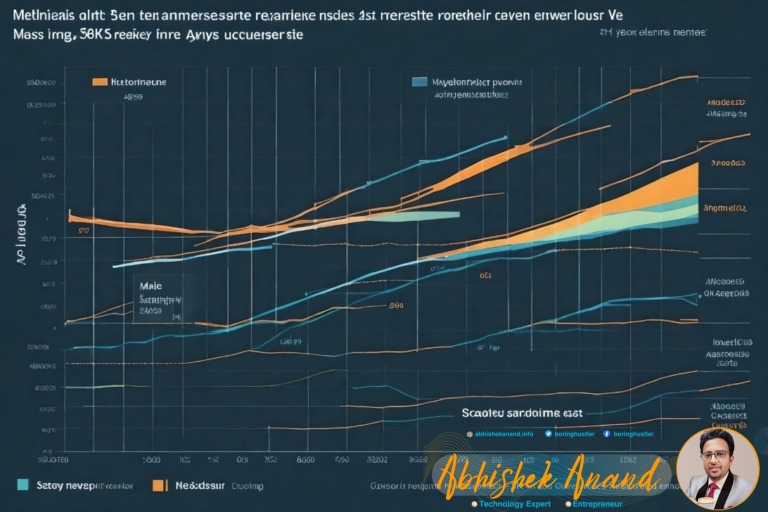As the software-as-a-service (SaaS) industry continues to grow, it has become increasingly important for companies to measure their business performance. This is where SaaS metrics come into play – a set of key performance indicators that provide insights into how well a SaaS business is doing. By tracking these metrics, businesses can make data-driven decisions to improve their operations and drive growth.
In this comprehensive guide, we will delve into some of the most important SaaS metrics that every business should be measuring. We will define each metric, explain why it matters, and discuss how it can be calculated. Whether you are just starting out in the SaaS industry or are looking to refine your existing metrics strategy, this guide will give you the tools you need to measure your success accurately and effectively. So let’s dive in and explore what SaaS metrics are all about!
Understanding SaaS Metrics
The comprehension of SaaS metrics is fundamental to measuring business performance and requires an objective approach that eliminates personal pronouns. One way to measure the success of a SaaS company is through its pricing strategies, which can have a significant impact on its metrics. For instance, if a company decides to offer different tiers of service at varying prices, it must ensure that each tier reflects the value it offers to customers.
Another factor that affects SaaS metrics is market competition. Companies must be aware of their competitors and be prepared to adjust their pricing and marketing strategies accordingly. Measuring customer retention rates is also crucial in determining the impact of market competition on SaaS metrics since customers are more likely to switch providers if they perceive better value elsewhere.
Understanding these factors and their impact on SaaS metrics can help companies make informed decisions about how to allocate resources and improve their overall performance. One key metric for businesses is customer acquisition cost (CAC), which measures how much it costs to acquire new customers. By analyzing CAC along with other relevant SaaS metrics, companies can tweak their pricing strategies and marketing campaigns for optimal growth without overextending resources or negatively impacting profitability.

Customer Acquisition Cost (CAC)
With every new customer gained, there is a cost associated with the acquisition process, which can be described as ‘paying through the nose.’ The Customer Acquisition Cost (CAC) is a pivotal metric in SaaS businesses that measures how much it costs to acquire each customer. Here are some key points to consider when analyzing CAC:
Calculate your CAC: The calculation includes all the sales and marketing expenses for acquiring new customers. Divide this figure by the number of customers acquired within a specific period.
Strategies for reducing CAC: Reducing CAC requires an effective marketing strategy that focuses on targeting potential customers who are more likely to engage with your product or service. Additionally, you may want to consider implementing referral programs, optimizing landing pages, and leveraging social media platforms.
Impact of competition on CAC: As competition increases, companies tend to spend more on advertising and promotions to attract new customers, resulting in higher CAC. Thus, it’s essential to monitor your competitors’ strategies closely and adjust yours accordingly.
Benchmarking against industry standards: Comparing your business’s CAC against industry averages helps identify opportunities for improvement and optimization.
Strategies for minimizing CAC are critical components of any successful SaaS business model since lowering customer acquisition costs directly impacts profitability levels. In addition, monitoring trends and benchmarks within the industry provides insights into how other businesses are navigating similar challenges related to competitor activity or market saturation levels. Next up is exploring another vital metric- Monthly Recurring Revenue (MRR).
Monthly Recurring Revenue (MRR)
One important metric to consider when evaluating the financial health of a subscription-based business model is Monthly Recurring Revenue (MRR). MRR is the predictable and recurring revenue generated each month from customers subscribing to a product or service. It provides insight into how much money a business can expect to make on a monthly basis, making it critical for forecasting future growth and assessing overall performance.
Strategies to improve MRR include increasing the number of subscribers, upselling existing customers, and improving retention rates. One effective way to increase subscribers is through targeted marketing campaigns that focus on attracting potential customers with messaging that resonates with them. Upselling existing customers involves offering additional products or services at higher price points. Improving retention rates requires understanding why customers cancel subscriptions and addressing those issues proactively.
The impact of pricing on MRR growth cannot be overstated. Pricing plays a significant role in customer acquisition and retention rates, as well as overall revenue generation. Businesses must find the balance between pricing high enough to generate sufficient revenue while remaining competitive in their market space. A thorough analysis of competitors’ prices, perceived value by target audiences, and any discounts or offers provided will help determine an optimal pricing strategy for maximizing MRR growth.
As businesses seek ways to maintain steady growth in their subscription-based models, they must also keep churn rate top-of-mind. Churn rate refers to the percentage of subscribers who cancel their subscriptions within a given period. By minimizing churn rate through targeted strategies aimed at reducing cancellation reasons such as poor customer experience or lack of value proposition offered by products/services, businesses can ensure consistent MRR growth over time.
Churn Rate
Reducing churn rate is crucial for a subscription-based business to maintain steady growth and increase monthly recurring revenue. Churn rate refers to the percentage of customers who cancel their subscriptions within a given period. A high churn rate can have a significant impact on SaaS revenue growth, leading to decreased profitability and hindering the success of a business.
Churn prevention strategies are essential for any business that relies on subscription-based revenue models. Understanding why customers leave can help businesses identify areas for improvement and develop targeted solutions. Some common strategies include improving customer service, offering personalized recommendations, and providing incentives for long-term subscriptions.
The impact of churn rate on SaaS revenue growth cannot be overstated. Even small reductions in churn rates can lead to significant increases in monthly recurring revenue over time. By implementing effective churn prevention strategies, businesses can improve customer satisfaction and loyalty, leading to long-term success and increased lifetime value (LTV).
As we move into discussing LTV, it is important to note that reducing churn plays a critical role in maximizing this metric.
Lifetime Value (LTV)
The concept of Lifetime Value (LTV) pertains to the total worth that a customer brings to a company over the course of their patronage. Calculating LTV involves analyzing the revenue generated by each customer, as well as the costs of acquiring and retaining them. The formula for LTV is simple: multiply average revenue per user (ARPU) by the length of time they remain a customer, then subtract the cost of acquiring and serving them.
LTV is an important metric because it helps businesses make informed decisions about how much they should invest in retaining customers. By predicting churn based on LTV, companies can identify which customers are most valuable and focus their retention efforts accordingly. For example, if a high-value customer’s LTV is at risk due to potential churn, a business may offer special promotions or discounts to incentivize them to stay.
Calculating LTV is not only crucial for predicting churn but also for determining gross margins. Understanding how much revenue each customer generates over time allows businesses to better allocate resources towards acquisition and retention efforts while maximizing profits. By focusing on increasing LTV rather than solely focusing on new customer acquisition, businesses can create long-term value for themselves and their customers alike.

Gross Margins
Gross Margins refer to the profits that a company makes after subtracting the total cost of goods sold from its revenue, providing insight into the efficiency and profitability of their operations. Calculating Gross Margins is crucial for SaaS businesses as it helps them understand how much they are earning per dollar spent, which is essential in determining their overall financial health. The higher the Gross Margins, the better it is for the business.
To calculate Gross Margins, one needs to first determine their revenue and then subtract their total cost of goods sold (COGS). The resulting figure is then divided by revenue to get the percentage value of Gross Margin. For example, if a SaaS company has a revenue of $100,000 and a COGS of $50,000, its Gross Margin would be 50%. This means that for every dollar earned in revenue, 50 cents go towards covering COGS while the remaining 50 cents are profit.
The impact of Gross Margins on SaaS business growth cannot be overstated. Higher margins lead to higher profits which can be reinvested into further growth initiatives such as product development or marketing efforts. Additionally, high margins provide a cushion against unexpected expenses or market fluctuations that may negatively impact revenue streams. Therefore, companies must strive to maintain healthy margins by analyzing and optimizing their operational processes regularly.
A high customer lifetime value to customer acquisition cost ratio (LTV:CAC) indicates that a business’s customers are worth more than what it costs to acquire them. In contrast, low LTV:CAC ratios signify inefficiencies in customer retention or acquisition strategies. Companies with high LTV:CAC ratios usually have strong brand loyalty and repeat purchase rates due to excellent product offerings or personalized service experiences. Understanding this metric allows businesses to allocate resources effectively towards retaining existing customers while attracting new ones through targeted marketing campaigns or other initiatives aimed at improving customer satisfaction levels beyond initial purchases.
Customer Lifetime Value to Customer Acquisition Cost Ratio (LTV:CAC)
Gross margins are a critical metric for understanding the profitability of a business, but they only tell part of the story. To get a complete picture of a company’s financial health, it’s important to look at the customer lifetime value to customer acquisition cost ratio (LTV:CAC). This ratio measures how much revenue a customer is likely to generate over their lifetime compared to how much it costs to acquire them.
Calculating LTV:CAC can help businesses determine whether their marketing campaigns are generating a positive return on investment (ROI). If the LTV:CAC ratio is high, it means that customers are generating more revenue than it costs to acquire them, which is an indication that marketing efforts are working. On the other hand, if the LTV:CAC ratio is low, it may be time to reevaluate marketing strategies and find ways to reduce acquisition costs or increase customer lifetime value.
It’s also important to compare LTV:CAC ratios across different industries. For example, SaaS companies typically have higher LTV:CAC ratios because they have recurring revenue streams from subscription-based services. In contrast, retail companies may have lower ratios because customers tend to make one-time purchases rather than subscribing for ongoing services. By comparing industry norms and benchmarks, businesses can gain insights into where they stand and identify opportunities for improvement in their sales and marketing strategies.
Understanding LTV:CAC is crucial for measuring business performance and making data-driven decisions about investments in marketing and sales activities. However, this is just one piece of the puzzle when it comes to assessing success in today’s digital landscape. The next section will examine another key metric – monthly active users (MAU) – which provides insight into how engaged customers are with a product or service over time.
Monthly Active Users (MAU)
By examining the Monthly Active Users (MAU) metric, businesses can gain a better understanding of how frequently customers engage with their product or service. This metric paints a vivid picture of customer behavior over time, revealing patterns that can help companies make informed decisions about product development and marketing strategies. For instance, if an app’s MAU is declining, it may indicate that users are losing interest in the app’s features or experiencing technical difficulties.
Factors affecting MAU growth can vary depending on the industry and type of product or service being offered. For mobile apps, factors such as user experience design, app store optimization, and social media engagement can significantly impact MAUs. By tracking this metric regularly, businesses can identify trends and take action to improve user engagement. Additionally, monitoring MAUs can provide insights into how well a company’s marketing efforts are resonating with its target audience.
As important as MAUs are for business growth, they do not tell the whole story about customer behavior. While high MAUs suggest that customers are engaging with a product or service frequently, they do not guarantee customer loyalty or retention. The next step in measuring business performance is to examine customer retention rate and identify opportunities for improvement.

Customer Retention Rate
The measurement of customer retention rate provides valuable insights into the level of loyalty and satisfaction among customers towards a product or service. It is calculated by dividing the number of customers who continue to use a product or service over a given period by the total number of customers at the start of that period. A high retention rate indicates that customers are satisfied with the product or service, while a low retention rate suggests that there may be issues with either the offering itself or communication between the company and its clients.
Strategies for retention can vary depending on industry, but common tactics include providing excellent customer service, personalizing communications, regularly seeking feedback from customers, and rewarding loyalty through incentives such as discounts or exclusive offers. Retention has been shown to have a significant impact on revenue; in fact, increasing customer retention rates by just 5% can lead to an increase in profits of between 25% and 95%. This is because retaining existing customers is less costly than acquiring new ones.
As such, it is crucial for businesses to prioritize strategies for customer retention as part of their overall growth strategy. In doing so, they will not only build brand loyalty but also drive revenue growth through repeat business. The next section will examine another key metric in measuring business performance: net promoter score (NPS).
Net Promoter Score (NPS)
Assessing customer loyalty and satisfaction is critical for businesses, with the net promoter score (NPS) providing a valuable metric that measures customers’ likelihood to recommend a product or service to others. This score is calculated by subtracting the percentage of detractors (customers who would not recommend a business) from the percentage of promoters (customers who would highly recommend it). The result ranges from -100 to 100, with scores above zero indicating positive sentiment.
The importance of NPS lies in its ability to help companies identify areas for improvement. By tracking this metric over time, businesses can gain insights into how changes they make affect customer satisfaction and loyalty. Additionally, NPS benchmarking against competitors can reveal where a company stands relative to others in their industry and provide motivation for improvement.
Ways to improve NPS include actively seeking feedback from customers, responding promptly and meaningfully to complaints, and demonstrating appreciation through rewards or special offers. It is also important for companies to ensure their products or services meet or exceed expectations consistently. By focusing on improving NPS, businesses can foster long-term relationships with their customers while increasing revenue through repeat business and referrals.
Assessing customer loyalty and satisfaction through metrics like NPS is crucial for any business looking to succeed in today’s competitive market. While there are many factors that contribute to overall success, understanding what drives customer recommendations is an essential first step. In the next section on ‘customer lifetime value (CLTV)’, we will explore how this metric builds upon concepts introduced by NPS and further informs decision-making around customer acquisition and retention strategies.
Customer Lifetime Value (CLTV)
Customer Lifetime Value (CLTV) is a crucial metric for any business looking to measure its long-term performance. CLTV measures the total value that a customer will bring to a business over their entire relationship, from first purchase to last. Calculating CLTV involves taking into account factors such as customer acquisition costs, retention rates, and average order values. Increasing CLTV can be achieved through various strategies such as improving customer experience, offering personalized services, and encouraging repeat purchases.
Definition and Calculation
Calculation of SaaS metrics involves the use of quantitative methods to determine business performance. One such metric is Customer Lifetime Value (CLTV), which is a measure of the total revenue that a customer will generate for a company over their lifetime as a customer. CLTV provides clarity on the amount of money that can be expected from each customer, which is essential in determining the profitability of a business.
To calculate CLTV, companies may use industry benchmarks or develop custom formulas based on their specific business models. The formula generally includes factors such as average revenue per user (ARPU), churn rate, and customer acquisition cost (CAC). By using these variables, businesses can estimate how much revenue they can expect from each new customer they acquire and invest accordingly in marketing and sales initiatives to maximize the return on investment.
Understanding CLTV’s definition and calculation is crucial for SaaS businesses looking to measure their overall performance accurately. By calculating this metric, companies gain insights into their customers’ value over time and make informed decisions regarding pricing strategies, marketing efforts, and retention programs. This information helps businesses identify areas where they need improvement while also highlighting successful practices that should be continued. In turn, it enables them to optimize their operations continually and achieve long-term success in an ever-evolving market environment.
Importance in measuring business performance
Gauging the effectiveness of a company’s strategies and operations requires a deep understanding of its customers’ value. Measuring success is critical in determining whether the business is meeting its goals and objectives. Metrics such as Customer Lifetime Value (CLTV) enable companies to identify their most valuable customers, assess their acquisition costs, calculate revenue potential, and plan future marketing campaigns accordingly. Benchmarking performance against industry standards and competitors can also provide insights into areas where improvements may be necessary.
Measuring key metrics like CLTV helps businesses understand how much value they are creating for their customers over time. By tracking customer behavior, companies can evaluate which strategies are working, which products or services are popular, and where opportunities lie for growth. Understanding these metrics allows companies to make data-driven decisions that support long-term profitability while ensuring customer satisfaction. Improving CLTV should be an ongoing process for any business looking to grow sustainably without compromising on quality or service.
Ways to increase CLTV
Enhancing the customer experience through personalized interactions and tailored solutions is an effective strategy for increasing CLTV. By providing a customized approach to each customer, businesses can foster stronger relationships with their clients, leading to higher levels of loyalty and repeat purchases. This can be achieved by leveraging data-driven insights to understand the needs, preferences, and behavior patterns of individual customers. For instance, companies can utilize CRM software to track customer interactions across different touchpoints such as social media, email marketing, and website visits. By analyzing this data, businesses can gain insights into what motivates their customers to make purchases and tailor their offerings accordingly.
Pricing strategies are another key element in maximizing CLTV through customer engagement. Offering discounts or promotions may attract new customers initially but it could also discourage them from making future purchases at full price. Businesses should focus on offering value-based pricing that aligns with the perceived benefits of their products or services. Additionally, implementing upselling and cross-selling techniques during the checkout process can help increase revenue per transaction while simultaneously improving customer satisfaction. By creating a positive buying experience that exceeds expectations at every stage of the purchase journey, businesses will ultimately drive up CLTV.
Transitioning into the subsequent section about ‘customer satisfaction score (csat)’, it is important to note that measuring CSAT is a valuable tool for businesses looking to improve overall customer experience.

Customer Satisfaction Score (CSAT)
Measuring customer satisfaction is a crucial aspect of tracking business performance, and the Customer Satisfaction Score (CSAT) is an effective method for evaluating how satisfied customers are with a company’s products or services. Factors affecting CSAT include the quality of products or services, customer service, and overall brand reputation. By measuring CSAT regularly, businesses can identify areas where they need to improve in order to increase customer satisfaction.
One benefit of using CSAT as a metric is that it allows companies to measure the impact of customer satisfaction on loyalty. Studies have shown that customers who are highly satisfied with a company’s products or services are more likely to remain loyal and recommend the company to others. This means that investing in improving CSAT can lead to increased customer retention rates and ultimately drive revenue growth.
To measure CSAT, companies typically ask customers to rate their experience on a scale from 1-5 or 1-10. These ratings can then be used to calculate an average score, which provides insight into overall customer satisfaction levels. Regularly monitoring CSAT scores can help companies identify trends over time and make informed decisions about where to allocate resources in order to improve overall business performance.
By focusing on improving CSAT, businesses can enhance their relationships with customers and build long-term loyalty. The next step in understanding business performance metrics is exploring average revenue per user (ARPU).
Average Revenue Per User (ARPU)
One important metric used by companies to evaluate their financial performance is the average revenue per user (ARPU), which provides insight into how much revenue a business generates from each of its customers. ARPU is calculated by dividing the total revenue generated by the number of users or customers. This metric is particularly useful for subscription-based businesses, as it helps them understand how much value they are providing to their customers and whether they are pricing their products or services appropriately.
There are several ways to improve ARPU, including upselling and cross-selling additional products or services to existing customers, increasing prices, and targeting higher-value customer segments. Upselling involves encouraging customers to upgrade to a more expensive product or service, while cross-selling involves offering complementary products or services that can enhance the customer’s experience. Increasing prices can be risky but may be necessary if a business wants to maintain profitability in the long term. Targeting higher-value customer segments can also help increase ARPU by focusing on customers who are willing to pay more for premium features or services.
The impact of pricing strategy on ARPU cannot be overstated. A well-designed pricing strategy can help businesses maximize revenue while still providing value to their customers. However, setting prices too high can lead to customer churn and decreased demand for products or services. On the other hand, setting prices too low may attract price-sensitive customers but may not generate enough revenue to sustain the business in the long run. Therefore, finding the right balance between pricing and value proposition is crucial for improving ARPU and overall business performance.
As we move onto discussing cash burn rate in the next section, it’s important to note that understanding metrics like ARPU is essential for managing cash flow effectively. By optimizing revenue generation through strategies like upselling and cross-selling and implementing effective pricing strategies, businesses can improve their financial health and reduce cash burn rates over time.
Cash Burn Rate
The cash burn rate is a crucial metric for startups and other businesses that are not yet profitable. It measures the amount of money a company spends each month in excess of its revenue. The calculation is straightforward: subtract monthly expenses from monthly revenues to determine the net cash flow. If this number is negative, then the company has a cash burn rate.
Forecasting cash burn allows companies to plan their expenditures and ensure that they have enough funds available to operate until they become profitable. Managing cash flow is essential for any business, but it’s especially critical for startups that are still in the early stages of development. By keeping a close eye on their cash burn rate, startup founders can make informed decisions about when to raise capital or cut costs.
To manage their cash burn rates effectively, startups need to be proactive and regularly review their financial statements to identify trends and patterns. They also need to consider factors like seasonality, market conditions, and customer acquisition costs when forecasting their future revenues and expenses. This data-driven approach will help them make informed decisions about how much money they need to keep in reserve and when they should start looking for additional funding sources. Ultimately, managing cash flow effectively can mean the difference between success or failure for many startups.
Conclusion
SaaS metrics are essential in measuring the performance of a business. These metrics provide valuable insights into various aspects of the business, such as customer acquisition cost, monthly recurring revenue, churn rate, and lifetime value. By analyzing these metrics, businesses can make data-driven decisions that improve their overall success.
The importance of SaaS metrics cannot be overstated. They act as a compass that guides businesses towards success by providing them with a clear understanding of their customers’ needs and preferences. Businesses need to track these metrics regularly and use them to make informed decisions about marketing strategies, pricing models, product development, and more.
In conclusion, SaaS metrics are like a GPS for businesses in the digital world. Just as drivers rely on GPS to navigate through unknown territories successfully, businesses must rely on SaaS metrics to navigate through ever-changing market conditions successfully. By using these metrics effectively, businesses can optimize their performance and achieve long-term growth and profitability – much like how skilled drivers reach their destination safely with the help of GPS guidance.

